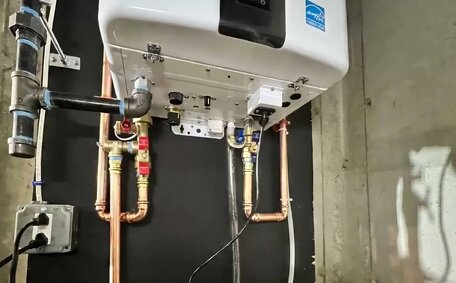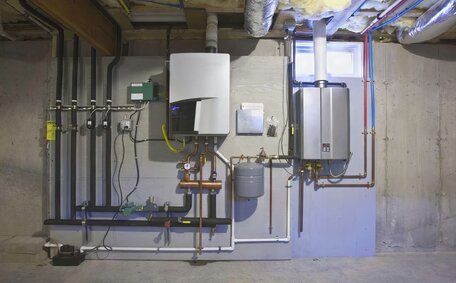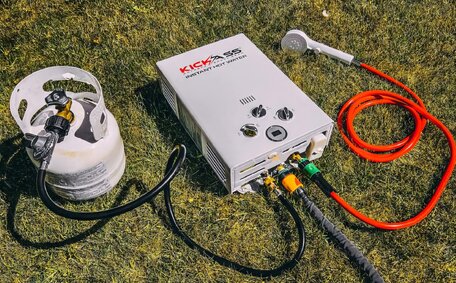Introduction to Pipe Relining
Pipe relining repairs damaged pipes beneath your property using a trenchless approach to avoid excavation. It involves inserting a resin-impregnated liner into the existing pipe and curing it to form a new pipe within the old one. This makes it an ideal solution for preserving the structural integrity of your property, particularly in heritage buildings.
Pipe relining allows for efficient pipe repair from the inside with minimal disruption to surrounding infrastructure. The relining process repairs various pipe damages, such as tree root invasion or leaks, with custom-fit liners tailored to your property’s needs, restoring full functionality.
Our Nuflow pipe relining methods use cutting-edge epoxy resins and liners strengthened with fibreglass or felt, ensuring durability. Pipe relining is a structurally robust, respectful solution that minimises disruption, aiding in the preservation of heritage buildings.
Understanding Pipe Systems in Heritage Buildings
Heritage buildings present unique challenges for plumbing repairs due to the need to preserve structural integrity and appearance. As historically significant structures, any work done must be minimally invasive.
Fortunately, there’s no need dig up delicate heritage ground, as pipe relining is well-suited for heritage buildings and repairs pipes from the inside with no excavation required. Pipe materials often found in heritage buildings like cast iron downpipes can be relined to restore function.
The pipe relining process involves inserting a resin-saturated liner into the existing pipe and curing it, which essentially allows us to create pipe within the old one. This technique can create a pipe within the existing structure, sealing cracks and holes while allowing the original pipe to stay intact, presenting an ideal solution.
Employing advanced epoxy resins and reinforced liners, pipe relining was very effective in providing long-lasting repairs without compromising the heritage status of buildings. It can resolve drainage issues in ceiling spaces, under floors and in walls while preserving structural stability.
By understanding the challenges of working with heritage structures, experts can use trenchless pipe relining technology to provide essential repairs with minimal impact on the preservation of these important historical buildings.
Blocked Pipes and Other Common Issues
Blocked drains are common problems affecting both modern and heritage-listed properties. Over time, heritage property drain pipes can become blocked by grease, soap residue, tree roots, and other debris. This restricts water flow, leading to backed up drains and flooding.
Fortunately, our drain specialist team offers a fast and effective solution through pipe relining without the need for major invasive work. Our team can tackle drain repairs by inserting flexible epoxy liners into the pipes, providing protective barriers within the obstructed passages. Once cured, the liner effectively creates a new pipeline, providing a seamless interior that seals cracks and holes while facilitating unimpeded water flow.
Our expertise extends to addressing pipe damage, fixing broken pipes, leaking joints, tree root invasions and general wear and tear in heritage buildings. Our Pipe relining techniques ensure that essential repairs carried out align with minimal disruption to the structure, appearance, and surroundings.
When it comes to drain repair through custom-fitted pipe liners sized to match your original drains, pipe relining restores function while preserving architectural heritage. Contact our dedicated plumbing team for professional advice on overcoming plumbing challenges in your heritage property.
Pipe Materials Used in Heritage Buildings
Heritage buildings often utilise vintage pipe materials like cast iron, galvanised steel, copper and lead. Fortunately, pipe relining can be used to repair common issues with these pipes regardless of size or material type.
Cast iron sewer line repairs, a staple in historical buildings, necessitate special attention during the process. Pipe relining is a gentle, non-invasive repair technique that restores function without damaging the original iron pipes.
Galvanised steel sewer pipes, pervasive and problematic in historic edifices, can undergo relining to tackle leaks, blockages, and additional dilemmas without substitution. The flexible epoxy liners adapt to the shape of your pipe, ensuring a precise and snug fit.
Relining pipe also works for lead, copper, clay and concrete pipelines found in heritage sites. Your local experts use advanced techniques to accommodate various pipe materials and diameters when relining your historical drains.
Benefits of Pipe Relining for Heritage Buildings
Pipe relining effectively addresses issues in old pipe systems within heritage buildings, offering multiple advantages. As a trenchless method, it avoids destructive excavation that could undermine foundations or damage precious heritage aesthetics.
Consider the following benefits of using pipe relining for heritage buildings:
- Non-invasive – Using trenchless technology, pipe liners are inserted without digging, preserving structural integrity
- Versatile – Accommodates various pipe materials like cast iron, lead, clay etc
- Long-lasting – Advanced epoxy resins provide durable repairs lasting 50+ years
- Cost-effective – Saves on pipe replacement and restoration expenses
- Efficient – Fast repairs with minimal disruption to occupants
- Preserving – Maintains original pipe infrastructure and appearance
Pipe relining enables critical repairs, ensuring the preservation status of heritage buildings isn’t compromised. It provides a structurally sound, non-destructive plumbing solution that can be carried out to resolve drainage issues across different pipe configurations.
Pipe relining is a vital service for heritage homes, remedying issues like blockage, root incursion, and leaks while maintaining historical significance.
Minimally Invasive Process
A key benefit of pipe relining is its minimal invasiveness; preserving roads and landscapes as there’s no need for excavation, thus protecting heritage buildings. Unlike traditional pipe replacement methods which involve extensive digging and destruction, pipe relining allows repairs from the inside of pipes.
The process begins with our specialists using CCTV cameras to thoroughly inspect the water pipe and identify any damage. Once assessed, a flexible epoxy resin liner reinforced with felt or fibreglass is saturated and inserted into your drain.
The liner expands and bonds to seal cracks, holes and joints. It is then cured using hot water or steam to harden the resin into a smooth, watertight pipe lining. Custom-fit to your pipes, the structural liner restores function while leaving surrounding infrastructure untouched.
With pipe relining, there is no need for jackhammers, saws or excavators which could undermine heritage foundations. The technology conveniently performs essential pipe repairs with minimal invasion, right at your historical structures.
Cost Savings Over Replacement
When it comes to plumbing repairs in heritage buildings, traditional pipe replacement methods can be extremely disruptive and expensive, not to mention the additional problems leaking through compromised pipes. They require extensive excavation to access pipes, threatening structural stability.
In contrast with more invasive strategies, pipe relining provides analogous restorations at a mere slice of the cost than traditional excavation and replacement. By inserting an epoxy liner into the existing pipes, cracks and leaks can be sealed without costly pipe replacement.
When it comes to relining vs pipe replacement, our expert guidance would highlight that when contemplating relining over full replacement, savings from 50% to 70% can be achieved with pipe relining as compared to full drainage replacement. There is also less business disruption, allowing heritage sites to remain open and operational.
Pipe relining prioritises modern methods to repair pipes, circumventing expensive restoration by obviating the need for conventional pipe replacement. It provides long-lasting repairs while preserving heritage infrastructure for generations.
Long Term Solution
One of the greatest advantages of pipe relining is that it delivers long-lasting solutions, extending the lifespan of drainage systems. Many companies can also offer extensive warranties of 50+ years on relined pipes due to the durability of modern materials.
We use high-tech epoxy resins reinforced with protective coatings that can outlast traditional pipes. The seamless interior surface enables water to flow smoothly from start to finish, ensuring an impeccable transport medium for liquids within the piping.
Opting for trenchless pipe relining brings long-term repair benefits to heritage buildings without recurring interventions. This avoids repeatedly undermining structural integrity.
With custom-fitted liners moulded to existing pipes, owners can guarantee high-performance, low-maintenance drainage for generations to come. Pipe relining is the ultimate long-term solution for safeguarding heritage buildings.
Considerations for Heritage Buildings
When undertaking pipe relining in heritage buildings, special care and consideration is required to preserve historical integrity.
It is crucial to adhere to regulations and guidelines for working with heritage sites. Experts should assess options thoroughly to use the least invasive methods possible. Process transparency and protection of aesthetics are also vital.
The good news is pipe relining itself is well-suited to the delicate nature of heritage buildings. The trenchless process involves no heavy machinery or excavation that could undermine structural foundations.
Call us to employ custom-fit epoxy liners moulded to existing pipes, where functionality can be restored without altering your pipe infrastructure. Relined pipes are even stronger than originals, providing reinforced stability.
In summary, considerations for heritage buildings include:
- Following heritage building codes and regulations
- Choosing minimally invasive repair methods
- Maintaining structural stability
- Preserving historical design and aesthetics
With care and oversight, pipe relining does a great job allowing essential upgrades while protecting the invaluable cultural heritage embodied in historical structures.
Preserving Original Materials and Aesthetics
Heritage buildings often contain original features like stonework, ironwork and historic artefacts that contribute to their cultural significance. It is crucial these materials and aesthetics are preserved during any repair or maintenance work.
Fortunately, This method can solve a plethora of issues while still maintaining the integrity of our heritage buildings. By inserting an epoxy liner into existing pipes, functionality can be restored without alterations to infrastructure or aesthetics.
The resin-impregnated liner conforms to the pipe’s interior walls, effectively sealing defects and cracks from within. Externally, original pipe materials remain undisturbed. Even heritage-listed structures with exposed pipework can benefit from invisible internal repairs.
Without needing heavy machinery or excavation, pipe relining prevents potential damage to the aesthetic surroundings. Structural stability also remains intact, including critical foundations. Essential upgrades occur without heritage buildings losing historical design elements or artefacts.
In summary, pipe relining delivers required plumbing repairs while allowing treasured heritage buildings to maintain their authentic original features and visual appeal for generations to come.
Meeting Building Regulations
When undertaking pipe relining in heritage buildings, it is crucial to adhere to regulations governing repairs and preservation. Heritage building codes often have strict requirements concerning structural integrity, aesthetics, materials, and inspection processes.
Fortunately, advanced pipe relining techniques align with many heritage regulations. By restoring pipe function from the interior without alterations, relining avoids undermining stability. The flexible liners mould to match original pipe shapes, preserving aesthetics.
Experts will assess your building’s heritage status and pipe layouts to select compliant relining and pipe upgrade solutions. With high-quality epoxy resins and reinforced liners exceeding 50+ year durability standards, relined pipes meet stringent regulations.
We liaise with relevant authorities concerning approvals for minimally invasive repairs. With care and oversight, essential upgrades occur without compromising heritage preservation laws. Pipe relining enables buildings to meet modern pipe performance standards.
Pipe Relining Process and Materials
The pipe relining process involves inserting a resin-impregnated liner into the existing pipe and curing it to form a new pipe within the old one. This allows the entire plumbing system to be restored without excavation or destruction to surroundings.
We use felt, fibreglass and epoxy resin liners that can be adapted to fit pipes of various shapes and sizes, including rectangular drains. The liners expand, up large enough to seal cracks and holes, bonding tightly to the old pipe walls. Curing with hot water or steam hardens the resin into a smooth, watertight new pipe.
Pipe relining is suitable for heritage buildings as it preserves original infrastructure externally while providing the ability to create pipe within existing lines for reinforced stability internally. With custom liners shaped to match the pipes right in your heritage property, functionality can be restored without alterations to materials or aesthetics.
CCTV Inspection
Comprehensive, environmentally friendly CCTV drain assessments can be carried out as an essential preliminary phase in deliberating pipe relining for heritage edifices. High-resolution camera probes allow detailed analysis of pipe interiors without any invasive demolition.
Experts carrying out thorough evaluations can assess the extent of damage, blockages, and tree root infiltration. Pipe dimensions, materials and layouts are mapped to design custom-fit liners. CCTV provides vital data to determine if relining is suitable and develop tailored solutions.
The technology aligns with strict heritage building regulations concerning non-invasive inspections. It also assists in gaining required council approvals before proceeding with repairs.
With precise pipe measurements and defect identification from CCTV, experts can fabricate resin-impregnated liners that will perfectly match existing infrastructure.
The data further allows relining specialists to choose optimal installation points and curing methodologies. By embracing advanced industry techniques like CCTV, essential repairs occur without damaging heritage structures.
Cured-in-Place Pipe Lining
Cured-in-place pipe (CIPP) lining is commonly used for repairing vertical pipes in heritage and other buildings. It involves inserting a resin-saturated felt tube into the damaged pipe and curing it in place using hot water or steam.
There was a time when fixing pipes required extensive excavation – the flexible felt liner material now is ideal for relining pipe patching, allowing it to conform snugly to the shape of the original pipe. Once cured, it forms a jointless, seamless pipe which effectively seals cracks, holes and joints. This restores structural stability and flow capacity.
CIPP lining is superbly apt to fix broken pipe infrastructure within heritage buildings as it circumvents the need for digging or the peril of marring adjacent visual charms. It can accommodate awkward vertical alignments like pipes in narrow wall cavities. The installation process also ensures no mess, with minimal noise and debris.
With advanced composite materials and steam curing methods, CIPP lining provides long-lasting repairs that can outlast the older pipes. It brings drainage systems up to modern standards while retaining historical infrastructure externally.
Conclusion
Pipe relining provides an innovative solution that can be carried out without need for invasive techniques, ideal for repairing and preserving drainage systems in heritage buildings. Drains can be rejuvenated from the inside out, as structural liners inserted restore pipe function and resolve issues like cracks, blockages, and root intrusion without external damage or excavation.
Understanding the importance of historical materials and aesthetics, our custom-fit epoxy resins allow for crucial upgrades while preserving valued heritage elements, ensuring client satisfaction and repeat business. The technology conforms with strict regulations on preserving structural integrity and historical design.
As a minimally invasive, long lasting and cost-effective trenchless method, pipe relining enables heritage buildings to meet modern plumbing standards. It protects our most treasured historical structures so they may remain intact for future generations to appreciate.






